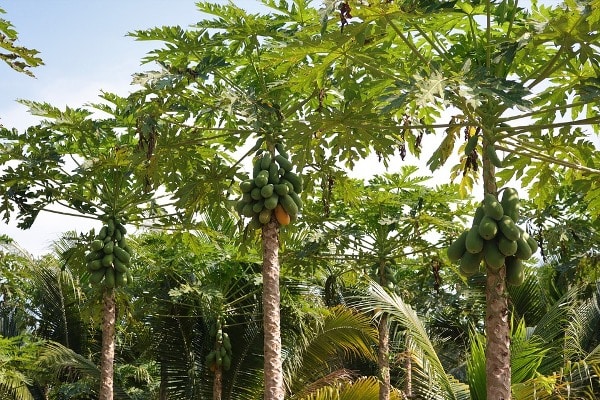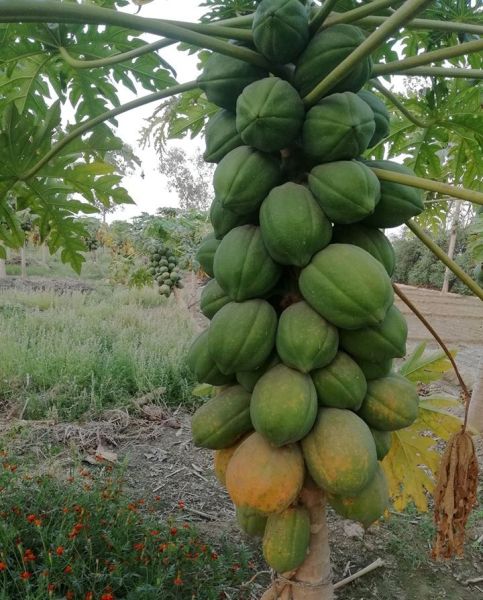Papaya Grafting Methods, Pruning Methods and Training:
The following information is about Papaya Grafting Methods, Pruning Process, and Training.
Grafting and Pruning of Papaya
Papaya which is scientifically called as Carica Papaya is one among the 22 species which are accepted from the Carica genes belonging to the family of Caricaceae. Papaya is originated from the American tropics, mostly from southern Mexico and the neighboring regions of Central America.
Papaya is a tropical tree which is very well-known for its leaves which are long and lobed. The fruits of papaya tree have tiny black seeds in them.
Papaya is a small tree which is branched in a sparse way. They generally grow with one stem which would be up to a length of 10 meters. The leaves of the papaya tree are arranged in a spiral way and these are confined to the upper level of the trunk. The lower trunk will have scars and that is the place where the birth of leaves and fruits take place. The papaya tree consists of large leaves which would be up to 30 inches in diameter and are have a shape which is similar to a hand with extended fingers. The flowers of the papaya tree have the scent which is sweet. These would open at night times and are also moth-pollinated. The fruit of the papaya tree would look like a berry which is large and will have a length of approximately 12 inches in diameter. The fruit is ripe and soft like a ripe avocado and the skin of the fruit will have an orange hue.
Read: Lemon Tree Pruning Methods.
Grafting a Papaya tree:
- You need to plant three seeds of papaya at a depth of half an inch in two of the containers. These containers should contain a potting mix which is well-drained. Now the seeds should be placed and the space between them should be even so that there would be sufficient room for their growth. Add water into both the containers so that the soil can get moistened.
- Now locate the containers at a place where full sun is available with a temperature of 23°C. Now provide heat to the bottom of the papayas which are being grown in containers so that there would be an improvement in the chances of success. You can also locate the containers in a window which is above a heat register or a radiator. Germination of seeds will take several weeks.
- You need to water the plants regularly in order to bring moisture to the soil, but make sure that you are not wetting the soil completely.
- Start thinning the plants so that only the papaya which is healthy will remain in each container. You need to be with patience and wait till the plants get at least three leaves before the process of thinning. Allow the plant to get matured for about one and a half or two months before the process of grafting continues.
- Sterilization of blades of shears or scissors should be done in alcohol or household bleach. This should take place for at least 15 minutes. After this, rinsing should be done, before commencing to cutting.
- You need to clip one inch of the papaya plantS top by using the scissors which are sterilized or the garden shears. Doing this would force the plant for the production of more number of branches for papaya grafting.
- Let the second plant grow. You should not touch it for another one and a half or two months and let it grow to a length of at least 10 inches.
- Now start cutting the top of the second papaya plant when it reaches a height of 10 inches and the branches of the first papaya plant reached the diameter of a pencil. You must leave at least 6 inches of the stock which is protruding from the soil.
- Cut at a depth of 1 inch. The cut should be a horizontal one into the second plant trunks top by using a grafting knife which is sterilized. This cut is called as a cleft and the trunk which has been cut is called as the stock in the cleft grafting process.
- Now remove one of the newly formed branches from the first plant by making use of a grafting knife. Remove the end of the papaya branch for the formation of the wedge. This particular piece which is removed is called as a scion.
- Slide the end of the scion which is cut into the cleft cut made in the trunk, the stock and second plant.
- Make sure that you are tying a piece of soft twine all around the stock tightly so that the stock which is present around the cion can be secured.
- The graft should be wrapped in a loose manner by making use of a grafting tape by making sure that the tape is completely covering the union in between the plants and also check that none of the parts of the cleft cut made in the trunk can be seen. This step is unnecessary but this would help for the prevention of infections caused by the bacteria when the graft is healing.
- The plant which is grafted should be placed in a warm shade for at least seven days. Take off the tape and twine after one week. Then, the healing of graft takes place and the growth of the plant will occur quickly in the environment which is warm and is having abundant sunlight.
Pruning a Papaya tree:

- The first thing you need to do is to wear the gloves and safety glasses prior to pruning a papaya tree. The latex sap of the papaya will lead to irritation of the skin in the individuals who are sensitive.
- Now take off all the dead leaves or the broken ones along with their stems by making use of loppers or anvil pruners. For the stems which are small, make use of anvil pruners. On the stems which are large and are under two and a half inch in diameter, make use of loppers.
- Pruning should be done for all the branches and they should be completely removed. The papaya tree will not develop any sort of branches usually until and unless there is any damage caused to the stem.
- Remove any sort of shoots which are sprouted from the papaya base. If the papaya tree is aged and if you observe that the production process is slowing down, allow the growth of one shoot after the harvesting is done, generally in the month of September. At the time of spring, cut the main stem and stake the shoot so that it would become a fresh fruiting system.
- Give an opportunity for the papaya tree which is grown very tall to revitalize. This can be done by removing the main stem in the spring, that is at least 3 feet from the level of the ground. Cover the stem which is remaining by using a garbage bag for protecting it from rain or water. There would be many shoots which would sprout rapidly from the papaya base. When the shoots would reach a length of 1 foot, choose the shoot which is the strongest as a new main stem. Take off all the other shoots.
Read: Rose Plant Grafting Methods.
Training of Papaya Tree:

- Well, training is one of the cultural activities should be carried out in the plantation of the papaya crop.
- As papaya trees are easy to break, they need good support until they are well established in the ground.
- Use any standard poles/sticks/support and it is better to grow windbreaker trees at the border of your field.
Read: Cinnamon Growing Information.
Sir,
I want to grow papaya in 2 acre land near Bhopal Madhya Pradesh. I am confused that which types of variety I should grow. Please advice me?
from where I can buy best seeds?
If there is any book of instructions or anything else. Please share.